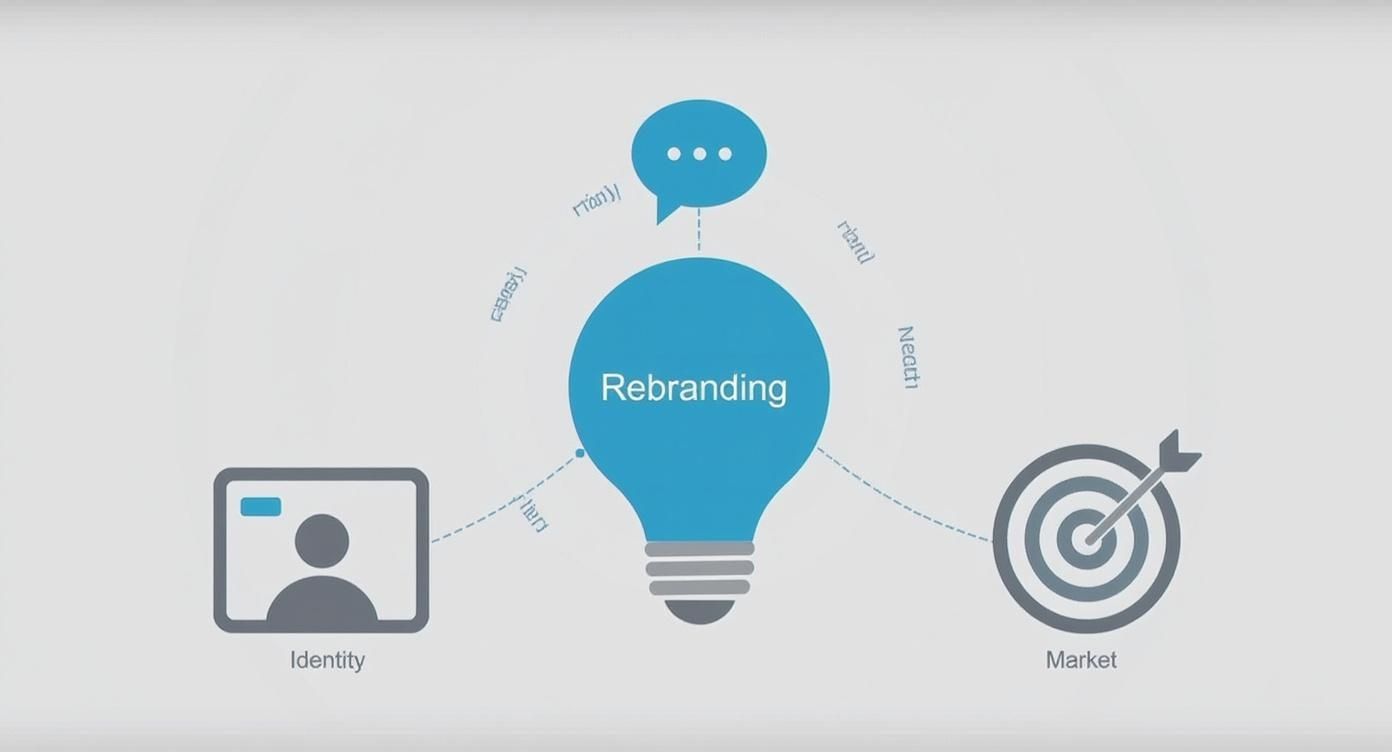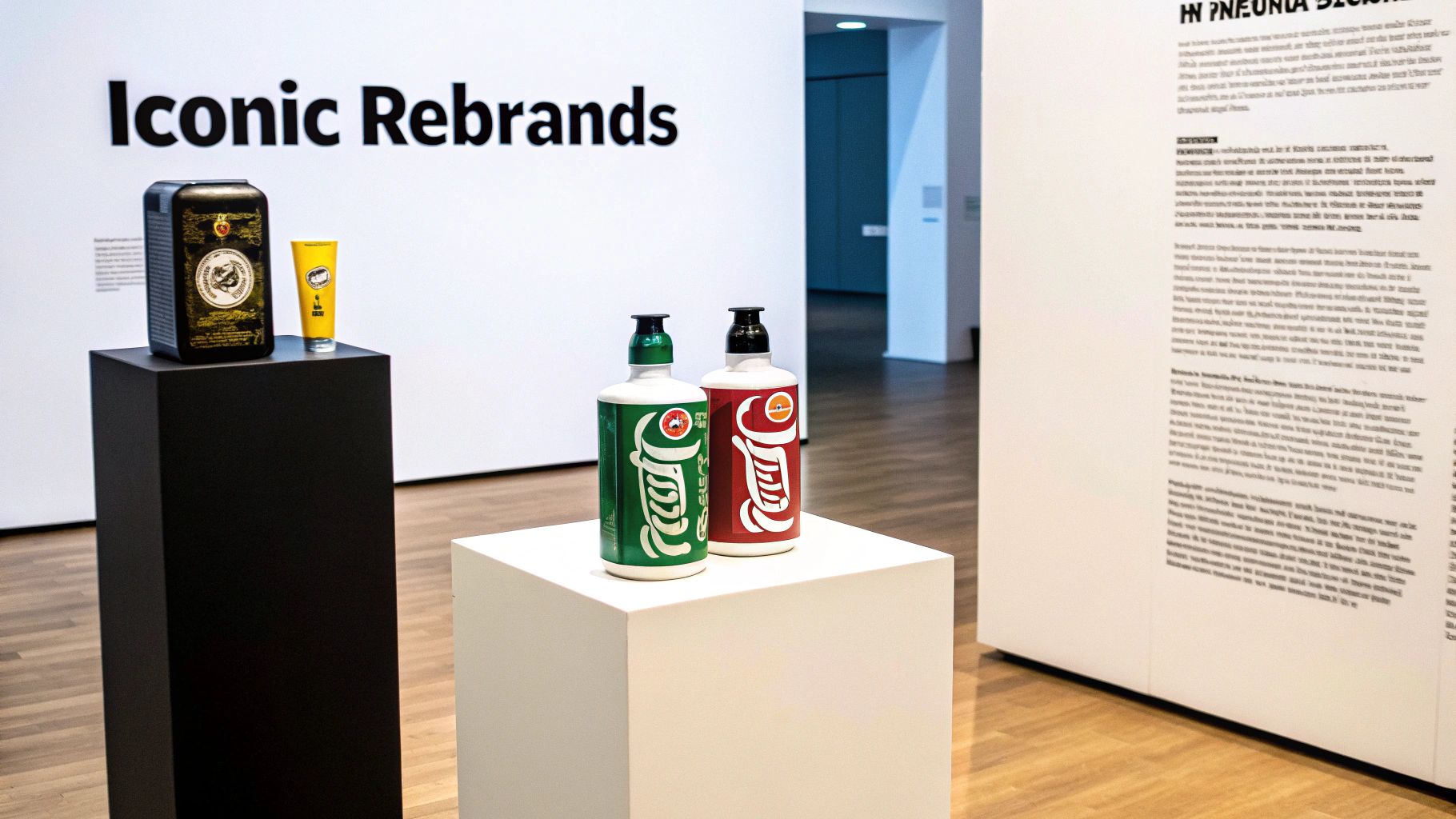So, what is rebranding, really?
It’s a whole lot more than just slapping a new logo on your website or picking a fresh color palette. Think of it less like a fresh coat of paint and more like a full-on home renovation for your business. Rebranding is the strategic process of changing a corporation's identity to carve out a new, distinct space in the minds of customers, partners, and everyone in between.
Understanding What Rebranding Really Means
At its heart, rebranding is about making a fundamental shift in how your company shows up in the world. It’s about digging deep and changing major parts of your brand to keep up with the market, connect with a new audience, or simply reflect that your business's core values have evolved. This kind of change ripples through everything, far beyond just the visuals.
And it’s not some rare, once-in-a-lifetime event. Far from it. A recent survey found that 82% of marketers have been part of at least one rebrand. Even more telling? 74% of S&P 100 companies go through a rebrand within their first seven years. It’s a standard—and necessary—play for staying relevant.
The Core Components of a Rebrand
So, what actually gets changed during this kind of transformation? It’s a mix of big-picture strategy and detailed execution across a few key areas. Before you even start thinking about logos, you have to nail down your company’s mission. If you're stuck, this guide on What's Your Brand's Purpose? is a great place to get some clarity.
This map here breaks down the main pillars you’ll be working with.

As you can see, a solid rebrand isn’t just one thing; it’s about pulling all the levers—identity, messaging, and market position—to create one cohesive, powerful new presence. It's all part of the much bigger game of shaping how people see you, which you can dive into with our guide on what is brand development.
To give you a clearer picture, let's break down what might be on the table during a rebrand.
The Core Components of a Rebrand at a Glance
| Component | What It Involves |
|---|---|
| Brand Identity | The visuals. Think logo, color scheme, typography, and imagery. |
| Brand Voice | How you talk. This covers your tone, messaging, and the personality that comes through in your copy. |
| Mission & Vision | Your "why." This is about redefining your purpose, values, and long-term goals. |
| Market Positioning | Where you fit. This might mean targeting a new audience or changing how you stack up against competitors. |
| Product/Service Offering | What you sell. Sometimes a rebrand is driven by a major shift in your core offerings. |
Each of these pieces works together. You can't just change your logo and call it a day if your company's mission has completely changed—it all has to align to be believable and effective.
The Strategic Triggers for a Rebrand
Companies don't just wake up one day and decide to rebrand. It’s a calculated, strategic move, usually sparked by some major internal or external shift. Think of it as a pivotal plot twist in the company’s story, one that completely changes its direction. These triggers are the signals that the old brand just can't carry the business into its future.
One of the most common reasons? Outgrowing the original brand. A quirky startup that begins in a garage might blossom into a serious industry leader. Suddenly, its playful name and logo start to feel like a suit that's two sizes too small, totally failing to reflect its expanded services or newfound authority.
Then there's the flip side: needing to shed a negative reputation. Whether it’s a PR crisis, a history of so-so quality, or just being tied to an outdated trend, a brand's image can get tarnished. In these moments, a rebrand is a public declaration that things have changed and a promise of a new way forward.
Responding to Market Shifts
Sometimes, the world just changes, and a brand has to change right along with it. A new competitor might storm onto the scene and shake everything up, forcing everyone else to redefine their value. A rebrand helps a company carve out its own space again, shining a light on what makes it unique in a suddenly crowded field.
Another huge trigger is a merger or acquisition. When two companies join forces, they need a single, unified identity that captures their combined strengths and culture. This usually means building a completely new brand from the ground up—one that honors the legacy of both while pointing to a shared future.
A rebrand is an opportunity to realign perception with reality. It’s the process of ensuring the story your brand tells on the outside perfectly matches the value and vision you’ve built on the inside.
Finally, a rebrand might be all about connecting with a new audience. A legacy brand could realize its loyal customers are aging, and it needs to bring in a younger crowd to stay relevant. This takes more than a slick new logo; it requires a deep dive into new values, communication styles, and cultural trends.
Spotting these disconnects usually starts with a hard look inward. To see how that process works, check out our guide on how to do a brand audit.
Building Your New Visual and Verbal Identity

Alright, you've nailed down the big-picture strategy. Now for the fun part—bringing it to life. This is where your brand's transformation becomes real, tangible stuff that customers will actually see, hear, and feel.
We're talking about building the new face and voice of your company. And no, it’s not just about slapping a new logo on everything. It’s about creating a whole new sensory experience, a system of sights and sounds that instantly tells your new story. Sugar Pixels has a fantastic guide on how to create a brand identity that really gets to the heart of making these genuine connections.
The Power of Visual Identity
Your visual identity is your brand's first impression, over and over again. It’s what people recognize in a split second. The right visuals can spark emotion, build instant trust, and make you stand out in a ridiculously crowded market.
And this isn't just fluffy design talk; the numbers are pretty staggering. Think about it: 75% of consumers recognize a brand just by its logo. A distinct brand color can crank up recognition by a whopping 80%. Get this visual consistency right across the board, and you could see a 23% jump in revenue. These aren't just design choices; they're serious business decisions.
So, what are the core pieces you need to get right?
- Logo: This is your brand’s signature. It needs to be memorable, work everywhere (from a tiny app icon to a giant billboard), and perfectly capture your new vibe.
- Color Palette: Colors are emotional shortcuts. A trustworthy blue, an energetic orange, a sophisticated black—your palette sets the mood before you even say a word.
- Typography: The fonts you pick say a lot. Are you a clean, modern sans-serif or a classic, elegant serif? Your typography is a key part of your brand's personality.
Crafting Your Verbal Identity
Just as crucial is what your brand says and how it says it. Your verbal identity—or brand voice—is the personality that shines through in your words. It's the difference between sounding like a stuffy corporate manual and a friendly, helpful human.
This voice needs to be everywhere, consistently. From your website copy and social media captions to the way your support team answers emails, it all has to sound like it's coming from the same place.
A brand's voice is its unique personality in written form. It ensures that no matter where a customer interacts with you, they feel like they’re talking to the same entity, which builds familiarity and trust over time.
To keep everyone on the team singing from the same hymn sheet, you need a set of ground rules. That's where brand guidelines come in. For a deep dive into putting these together, check out our guide on how to create brand guidelines.
Rebranding Success Stories From Iconic Brands

The theory behind rebranding is great, but seeing it in action? That's where the real lessons are. Some of the world's most recognizable companies have completely changed their destinies with a single, gutsy rebrand.
These stories are more than just trivia; they’re a blueprint for how to pivot, reconnect with an audience, and spark incredible growth. Let's break down two of the most legendary transformations we've seen.
Old Spice: From Dated Aftershave to Viral Sensation
For years, Old Spice was "the stuff your grandpa used." That’s it. Its customer base was aging out, and the brand felt totally disconnected from anyone younger. It was on a slow, one-way track to irrelevance.
The mission was clear: grab the attention of a younger crowd without completely alienating the loyal old-timers. The answer was a total identity overhaul, capped off by the now-iconic "The Man Your Man Could Smell Like" campaign in 2010.
This rebrand was an absolute masterclass in flipping a narrative:
- A New Target: Instead of marketing to men, they started talking to the women who were buying grooming products for them. Genius.
- A Voice Makeover: The stuffy, old-fashioned sailor vibe was thrown overboard. In its place came a voice that was witty, absurdly confident, and hilarious.
- Modern Playground: Old Spice jumped headfirst into YouTube and social media, creating viral videos that people actually wanted to share.
The results? Absolutely staggering. The campaign racked up over 1.2 billion media impressions and sent sales soaring by 125% year-over-year. Just like that, Old Spice was cool again.
Burberry: From Stale Heritage to Modern Luxury
Back in the early 2000s, the British luxury brand Burberry had a huge problem. Its famous checkered pattern had been so overused and co-opted by UK "chav" culture that it was killing its high-end appeal. The brand felt tired and had lost its exclusive shine.
With new leadership at the helm, the goal was to reclaim Burberry's spot as a top-tier luxury fashion house. This meant a strategic retreat. They drastically reduced the visibility of the classic check, pushed fresh designs, and fully embraced digital to reach a global, fashion-forward audience.
By leaning into its history of innovation and high fashion—not just its pattern—Burberry completely transformed its reputation. Today, it’s a symbol of modern British luxury, proving that even a storied brand can reinvent itself for a new generation.
Modern Trends That Shape Rebranding Strategy

A smart rebrand today is about so much more than just hitting internal business goals. It's a direct conversation with the huge shifts happening in culture, technology, and what people actually value. The forces shaping public opinion are powerful, and if a brand wants to stay relevant, it has to evolve with what its audience genuinely cares about.
One of the biggest drivers right now is the demand for social and environmental responsibility. People aren't just buying products anymore; they're supporting brands that mirror their personal values. That shift from just being a consumer to being an advocate is a massive force behind modern rebranding.
Sustainability is a perfect example. The customer demand for eco-friendly practices has pushed companies like H&M to pledge the use of only recycled or sustainably sourced materials by 2030. You also see it with PepsiCo’s Aquafina, which shifted its packaging to 50% recycled plastic—a clear signal of a real operational pivot. Then you have tech giants like Google and Microsoft branding themselves as carbon neutral, broadcasting their commitment to renewable energy to the whole world.
If you want to dig deeper into how these shifts are playing out, SmashBrand has a fantastic breakdown of current rebranding trends.
The Rise of Technology and Personalization
Technology is the other major force pushing brands to reinvent themselves. With the explosion of artificial intelligence (AI) and data analytics, companies can understand their customers on a level that was unimaginable just a few years ago. This opens the door to hyper-personalized experiences, which is no longer a "nice-to-have"—it's an expectation.
A brand that can anticipate a customer's needs and communicate with them on a one-to-one basis doesn't just sell a product; it builds a genuine relationship. Rebranding in this context often means overhauling the entire customer journey to feel more personal and intuitive.
This tech influence also bleeds directly into visual identity. AI tools are now being used to generate logo concepts, test out new messaging, and even uncover unique color combinations for logos that connect with very specific audiences. Leaning into these tools helps brands create identities that aren't just fresh for today, but built to adapt for whatever comes next.
A Few Common Questions About Rebranding
Jumping into a rebrand always brings up a bunch of practical questions. Let's walk through some of the most common ones to clear things up and give you some solid, straightforward answers.
Rebrand vs. Refresh: What’s the Real Difference?
It helps to think of it like working on a house.
A brand refresh is like giving a room a new coat of paint or swapping out the furniture. You’re modernizing the look and feel, but the core structure—the foundation—is still the same. This usually means updating your logo, maybe tweaking the color palette, or sharpening up your messaging.
A full rebrand? That's a gut renovation. We're talking about knocking down walls and completely changing the floor plan. This is a fundamental shift in your mission, values, and how you position yourself in the market. It’s a signal to the world that your business is heading in a major new direction, not just getting a cosmetic touch-up.
How Do You Actually Measure Success?
Figuring out if a rebrand worked is about more than just asking, "So, do people like the new logo?" You need to look at real business metrics to see if the whole effort actually hit its strategic goals.
The ultimate test of a rebrand isn't whether it looks better, but whether it works better. Success is all about its impact on how people see your brand, how they engage with you, and—most importantly—your bottom line.
A few key things you’ll want to track:
- Website Analytics: Keep an eye on traffic, bounce rates, and conversion rates. Are more of the right people sticking around and taking action?
- Social Media Engagement: Look for a jump in mentions, follower growth, and positive comments. Is the new brand getting people talking?
- Brand Recognition Surveys: Run some polls before and after. Has awareness or perception improved?
- Sales and Lead Generation: At the end of the day, is the rebrand bringing in more qualified leads and driving revenue?
What Are the Biggest Risks to Avoid?
The single biggest risk is a disconnect between your shiny new brand and what customers actually experience. If you’re suddenly promising innovation but your service or product is stuck in the past, you'll lose trust in a heartbeat.
Another major pitfall is failing to explain why you’re changing. If you don't bring your audience along for the ride, you risk leaving them confused, or worse, feeling alienated.
Finally, don’t underestimate the cost. A rebrand can get expensive if it’s not planned out properly. If you want to get a better handle on the potential costs for the visual side of things, our guide on how much a logo costs is a great place to start.
Ready to bring your new brand identity to life? The talented designers and branding experts on Creativize are ready to help you build a brand that connects. Find your creative partner today!

